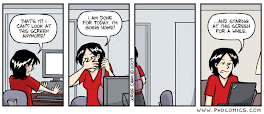Besides the four important routes that the visual information makes to process it (and that I already showed you in the previous post), there are certain stimuli that get in through the eyes and also that go to other nervous system pathways to cause the right answers.
EXAMPLE 1:
When we get across a tunnel, we turn on the car headlights on, but even so, our eyes have to get used to the sudden decrease of the light in order to see clearly again, and drive safely.
In order to achieve this action, this information arrives to the PRETECTUM (a structure in the mesencephalon next to the Superior Colliculus). This structure sends the information about “poor light”, to the EDINGER-WESTPHAL NUCLEUS and from there, finally to the CILIARY GANGLION. This last structure sends a command to the DILATOR MUSCLE of the iris, in order to increase the pupil size (i.e. it dilates), and so, to get more light into the eye. Thus, the rods of the retina are stimulated, and they give us the information that we need in order to keep on driving in those conditions.
When we get out the tunnel, the process is shorter. The information about “much light”, stops in the EDINGER-WESTPHAL NUCLEUS, who sends a command to the SPHINTER MUSCLE of the iris in order for the pupil to decrease its size (i.e. it contracts), less light gets into the eyes and therefore so we are not dazzled at all so we can see clearly quickly.
EJEMPLO 2:
The “STOP” sign one: Everything gets inside through the eyes, but as I explained in the previous post, the Lateral Geniculate Nucleus (LGN), is responsible for filtering this information so that the brain is not saturated with unnecessary information. So, the ATTENTION is involved in this process and that “attentional window” is controlled through another nucleus placed in the Thalamus: PULVINAR.
There are two routes: in one hand, the route that “facilitates the attention” and that leads it to one or another object (the STOP sign, the white line, the car in front of us…) or increase its attention range (we pay attention to everything surrounding us, to what is the car that has priority to get out of the STOP sign cross in the first place,….). And this information passes through the Pulvinar.
In the other hand, the route that “inhibits the attention” (children playing in the car behind, the shopping bag that falls over when we press the brake,…). This route is direct between the Lateral Geniculate Nucleus and the Occipital Lobe.
These routes are MAGNO, that is, unconscious routes. Fortunately we do not have to control consciously everything at the same time and many of previous routes: if we had to, a simple “STOP” sign will be chaotic.
But besides these examples or these nervous structures, there are many others with the same importance, that are also involved in this visual information processing.
For instance, the CEREBELLUM. It is the structure responsible for the coordination, the balance and the movement; therefore, it allows us to do precise movements in order to position the car right before the white line, put our hand on the wheel, put our foot on the brake pedal,…
Another example is the HIPPOCAMPUS. It is a structure located in the medial temporal lobe and is structure responsible for long and short term memory; therefore, it allows us to remember what the traffic sign means, what we have to do before it, what streets we have to take to arrive to our office, what breakfast we had breakfast this morning,…
As you see, when we are driving a car it is not only important the “what” but also the “where”, that is, we not only see the sign and see it clear, but also to need to know and interpret it: recognizing it, identifying it, remembering it, relating to the rest of information that we have, ignoring whatever it does not contribute, knowing how to act before it, knowing what we can or must do, how long and where we can move according to where we are,…
That is, in order to drive a car, to play tennis or just to walk or to move from one place to another, if we only have a picture of the things that we see, our brain can not make those judgements that are so necessary.
RELATED POST
Where does what we see go? - Visual Information Processing (from the eye to the brain)














